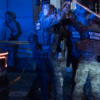On March 18, 2025, the fragile ceasefire that had offered a glimmer of hope to the war-torn Gaza Strip collapsed as Israel unleashed what it called a “massive offensive” against Hamas. The overnight bombardment, the most intense since a truce took effect in January, has killed at least 326 Palestinians, including many children, according to Gaza’s health ministry. With over 440 wounded and countless others feared trapped under rubble, the renewed violence has sparked widespread fear, grief, and international condemnation.
A Sudden and Deadly Escalation
The Israeli Defense Forces (IDF) announced the offensive with a stark warning on X from Arabic spokesperson Avichay Adraee: “The IDF has launched a massive offensive against terrorist organizations. These designated areas are considered dangerous combat zones!” Accompanied by a map highlighting swathes of Gaza in red, the post ordered civilians in neighborhoods like Beit Hanoun, Khirbet Khuza’a, Abasan al-Kabira, and al-Jadida to evacuate to shelters in western Gaza City and Khan Younis. The border fence area, a hotspot since fighting erupted on October 7, 2023, has now expanded, pushing the danger zone deeper into the enclave.
The strikes began around 2 a.m., jolting residents awake with relentless explosions. Dr. Razan Al-Nahhas, a volunteer physician at Al-Ahli Hospital in Gaza City, described the scene as “absolutely horrific.” Speaking to CNN, she recounted, “Babies, children all over the floor, bleeding from their heads, bleeding from their abdomens. I just was taking care of a 7-year-old boy who was gasping and taking his final breaths, begging me to save him after his entire family was killed.” With bodies piling up outside—many wrapped in blankets due to a lack of morgue space—the healthcare system, already on its knees, teeters on the brink of collapse.
A Humanitarian Crisis Deepens
The Norwegian Refugee Council (NRC) warned that this resumption of hostilities will exacerbate an already dire humanitarian crisis. Shaina Low, an NRC communications adviser, told CNN from Jordan, “People, including our staff, are in shock. They are very stressed out and worried about what is to come.” Gaza’s health ministry reported that rescue efforts are underway, but many victims remain buried under rubble, a grim reality echoed by Muhammad Abu Salmiya, head of Al-Shifa Hospital, who said, “The wounded are dying without finding a bed for treatment.”
Israel’s blockade of food, water, and electricity—intensified in recent weeks to pressure Hamas into releasing hostages—has left Gaza’s 2.3 million residents in a stranglehold. The brief respite offered by aid trucks during the ceasefire has evaporated, raising fears of famine and disease. United Nations Secretary-General António Guterres had warned last month that a return to full-scale war would “lead to an immense tragedy.” That prophecy now seems to be unfolding.
Global Reactions and Regional Tensions
The international community has reacted with alarm. China, expressing “high concern,” called for a return to the ceasefire, with foreign ministry spokesperson Mao Ning urging all parties to “avoid actions that could escalate the situation.” The Netherlands, a historical ally of Israel, joined the chorus, with Foreign Minister Casper Veldkamp demanding a “permanent end to hostilities” and the protection of civilians. Even Yemen’s Houthis, themselves under U.S. attack, pledged continued support for Palestinians, vowing to “escalate confrontation steps.”
The strikes coincide with heightened Middle East tensions. The U.S., under President Donald Trump, recently bombed Houthi targets in Yemen, while cross-border clashes flare between Lebanon and Syria’s new Islamist-led government. Israel notified the Trump administration before the Gaza offensive, with White House press secretary Karoline Leavitt affirming Trump’s stance: “Hamas, the Houthis—all those who seek to terrorize not just Israel but also the United States—will see a price to pay.”
A Ceasefire in Tatters
The ceasefire, brokered in January after 17 months of war that claimed over 48,000 Palestinian lives, was already faltering. Phase one ended two weeks ago, with negotiations deadlocked over extending the truce and freeing the remaining 60 Israeli hostages—fewer than half believed to be alive—taken during Hamas’ October 7, 2023, attack. Israel accuses Hamas of rejecting offers to release captives, while Hamas claims Prime Minister Benjamin Netanyahu scuttled the truce to “resume war.” Ezzat al-Rishq, a Hamas leader, called the strikes a “death sentence” for the hostages.
Netanyahu, alongside Defense Minister Israel Katz, vowed to wield “increasing military strength” against Hamas, with an Israeli official describing the attack as “preemptive” and promising expanded operations. The IDF claims to target mid-ranking commanders and infrastructure, but the civilian toll tells a different story—hospitals from Al-Awda in the north to Nasser in the south report strikes on homes, leaving children among the dead.
What Lies Ahead?
As smoke rises over Gaza City and families flee with whatever they can carry, the specter of mass displacement looms. The IDF’s evacuation orders, coupled with a total blockade, leave civilians with nowhere safe to turn. Photos from Beit Hanoun show a girl balancing blankets on her head as displaced residents trudge toward an uncertain fate in Gaza City.
For Palestinians, the resumption of war shatters a fleeting calm during Ramadan, plunging them back into a nightmare of loss and survival. For Israel, it’s a calculated escalation in a conflict with no clear end. For the world, it’s a stark reminder of a crisis spiraling out of control—one that demands more than words to halt the carnage. As Dr. Al-Nahhas put it, watching bodies pile up outside her hospital, “They keep bringing more.” The question now is how many more—and for how long.








